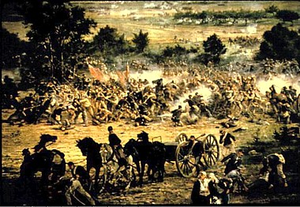I read an article in the New York Times today that proclaimed the end for GM's Pontiac. It made me sad - but I was not surprised. Pontiac has been languishing for years in the backwaters of the troubled automaker. Pontiac died a quiet death at age 84. But like many obituaries of older folks whose family show a picture of the Dearly Departed from their younger years, I want to remember the Pontiac when it was young and vibrant.
Pontiac introduced their compact car line, dubbed the Tempest, in the Fall of 1960. The first Tempest was intended to be a fuel sipping family hauler. That first year, the car had an innovative drivetrain with the transmission from the Corvair mounted in the rear to flatten the hump in the middle of the front passenger compartment normally created by the transmission. By 1963, the car had grown from Compact to Intermediate class and like all cars of that era, higher-performance engines became an option. The transmission moved back up front to take the beefed-up torque of these larger engines which had a 326 cubic-inch displacement. These small V8s were a hit with consumers and the restyled 1964 Tempest Lemans was offered with a factory option for the larger-bore-in-the-same-block, 389 cubic-inch V8. This true Muscle Car was the brain-child of Pontiac's Chief Engineer, John DeLorean, and was dubbed the Pontiac GTO.
The 1964-65 GTO's remain at the pinnacle of desirable collector cars. Restored to pristine condition, these hunks of mid-60s steel can easily bring over $100,000 at auction. I would guess that most of the buyers are guys my age who always dreamed of owning one of these exotic machines from their long-ago youth. In my high school years, I thought the GTO was second only to the Corvette as the coolest car on the road. I never could have bought one, of course. I could barely afford the tiny Honda CB160 motorcycle that was my only way of getting around. But I was luckier than most. I had the right high school friend.
 |
| 1965 Pontiac GTO Couple |
 |
| 1965 Pontiac LeMans Convertible |
The first year after graduating from high school, my best friend had managed to buy a 1965 deep burgundy GTO convertible by working out a loan with his very lenient father. The '65 GTO had (and maybe still has) the best body style of any car in its class. The over-under, forward-raked headlights and the clean grill looked as though it could just knife the air. The bulge on the GTO's hood looked like a pair of flared nostrils. The four-on-the-floor (with the white billiard-ball shift knob) was the lever to All Power. The lines were clean and uncluttered - unlike so many cars of the day - and beautifully proportioned.
I got to drive this car... once. Well, maybe twice. But the time I remember was when I was driving it in the high school homecoming parade with one of the princesses sitting up on the convertible boot in the back seat. My friend, the owner, couldn't drive because he was in another float in the same parade and had asked me to take the wheel. I did my very best to look totally bored with the experience. (Such a Guy Thing at age 18.) Never once did I let on that I wanted to do handsprings down the middle of the street because I felt SO COOL! My Fifteen Minutes of Fame had arrived. My biggest challenge was not inadvertently popping the very stiff clutch and send my homecoming princess flying off the trunk lid or stalling the car in the middle of the parade. I managed without mishap.
I didn't get my own car until a couple of years later. It was not a Pontiac GTO. It was a used VW Bug that struggled to get up to highway speed. The GTO was definitely another kind of automobile and I will always remember it fondly. It was iconic. It defined the times. Pontiac went on to get older, heavier, slower. (Sounds like what happened to us.) Now, it is gone. But when I see these classic GTOs at a car show, I still want to grin. They were fun in a way that cars today can never be. At least, not to me.









